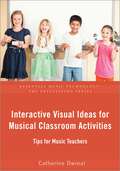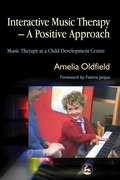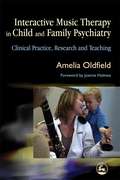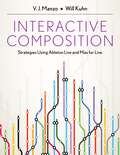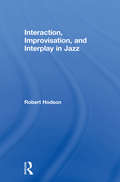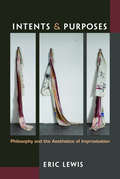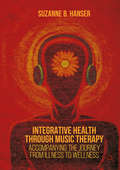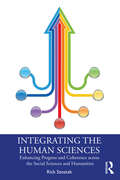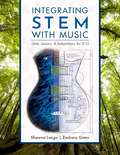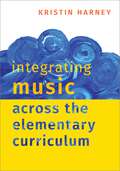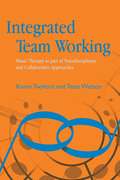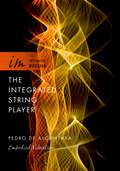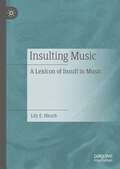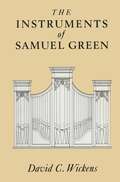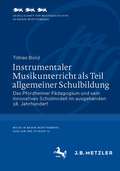- Table View
- List View
International Handbook of Research in Arts Education (Springer International Handbooks of Education #16)
by Liora BreslerProviding a distillation of knowledge in the various disciplines of arts education (dance, drama, music, literature and poetry and visual arts), this essential handbook synthesizes existing research literature, reflects on the past, and contributes to shaping the future of the respective and integrated disciplines of arts education. While research can at times seem distant from practice, the Handbook aims to maintain connection with the live practice of art and of education, capturing the vibrancy and best thinking in the field of theory and practice. The Handbook is organized into 13 sections, each focusing on a major area or issue in arts education research.
Interactive Visual Ideas for Musical Classroom Activities: Tips for Music Teachers (Essential Music Technology:The Prestissimo Series)
by Catherine DwinalThe digital interactive projection system is a staple of nearly every music classroom in the United States. By allowing teachers to show students methods and outcomes from a computer, these systems have become a necessity for reaching students who grew up as digital natives. But, as author and distinguished music educator Catie Dwinal demonstrates, such systems can be much more meaningful pedagogical tools than simple replacements for chalk boards. In this book she offers practical tips, tricks, resources, and 50 activities ideal to use alongside classroom projection systems. She focuses especially on tips and activities for beginning teachers, giving them the confidence to take a step out of their comfort zone and learn new ways of engaging students with technology. More than this, she provides reference materials that will serve as a trusted reference resource for years to come.
Interactive Visual Ideas for Musical Classroom Activities: Tips for Music Teachers (Essential Music Technology:The Prestissimo Series)
by Catherine DwinalThe digital interactive projection system is a staple of nearly every music classroom in the United States. By allowing teachers to show students methods and outcomes from a computer, these systems have become a necessity for reaching students who grew up as digital natives. But, as author and distinguished music educator Catie Dwinal demonstrates, such systems can be much more meaningful pedagogical tools than simple replacements for chalk boards. In this book she offers practical tips, tricks, resources, and 50 activities ideal to use alongside classroom projection systems. She focuses especially on tips and activities for beginning teachers, giving them the confidence to take a step out of their comfort zone and learn new ways of engaging students with technology. More than this, she provides reference materials that will serve as a trusted reference resource for years to come.
Interactive Music Therapy - A Positive Approach: Music Therapy at a Child Development Centre
by Fatima Janjua Amelia OldfieldIn Interactive Music Therapy - A Positive Approach, Amelia Oldfield explains how her approach to music therapy sessions establishes a constructive musical dialogue with children that emphasises positive experiences - these establish trust and allow feelings to be expressed through music. Describing the general benefits of this approach, the author also details its application for specific clinical groups including children with autistic spectrum disorders, relationship difficulties or physical disabilities. Individual chapters focus specifically on child development issues and in child and brief case studies throughout the text illustrate points of particular importance. This practical book will be of use to other clinicians and teachers working with children with a variety of needs, including children on the autism spectrum and children with learning disabilities. It is also of use to music therapy trainers, their students and academics whose interests include music therapy.
Interactive Music Therapy - A Positive Approach: Music Therapy at a Child Development Centre (PDF)
by Amelia Oldfield Fatima JanjuaIn Interactive Music Therapy - A Positive Approach, Amelia Oldfield explains how her approach to music therapy sessions establishes a constructive musical dialogue with children that emphasises positive experiences - these establish trust and allow feelings to be expressed through music. Describing the general benefits of this approach, the author also details its application for specific clinical groups including children with autistic spectrum disorders, relationship difficulties or physical disabilities. Individual chapters focus specifically on child development issues and in child and brief case studies throughout the text illustrate points of particular importance. This practical book will be of use to other clinicians and teachers working with children with a variety of needs, including children on the autism spectrum and children with learning disabilities. It is also of use to music therapy trainers, their students and academics whose interests include music therapy.
Interactive Music Therapy in Child and Family Psychiatry: Clinical Practice, Research and Teaching
by Jo Holmes Amelia Oldfield'What is truly distinctive about this book is that Oldfield introduces her doctoral research, in which she created the Music Therapy Diagnostic Assessment (MTDA) in comparison to one of the most internationally recognized standardized diagnostic tool.' - Autism Diagnostic Observation Schedule (ADOS). 'I believe that the book will be useful for music therapy students, and novice music therapist working in child and family psychiatry and related fields.' - Nordic Journal of Music Therapy 'In her indomitable, accessible and straightforward style, Amelia Oldfield continues to champion the use of music therapy with families in her most recent publication. The book is in many ways a step-by-step music therapy manual, informing us of music therapy methods and innovations and provoking new thoughtfulness for work within the child mental health setting.' - Journal of Family Therapy 'This book could be an invaluable resource for readers who are looking for evidence that music therapy can have a very positive effect on certain disorders and family dynamics. I could imagine it would bring great hope for those whose children find communication very difficult, or where families are struggling to relate emotionally. The book [also] has a lot of clinical research data, which would be extremely useful for students or clinicians needing to validate this kind of work.' - ACCord Magazine 'This practical book outlines and explains the rationale for using music therapy in child and family psychiatry. Amelia Oldfield reflects on current research methodology and describes characteristics of her own approach to therapy sessions, including how to start and end the session, how to motivate children and establish a positive musical dialogue with them, and how to include parents in the session. She also uses video analysis techniques to assess and advance the role of the therapist. Individual chapters focus on the results of the author's research investigations with specific groups such as mothers and young children, groups of adults with profound difficulties, children with autistic spectrum disorder or severe physical and mental difficulties, as well as children without clear diagnosis. Case studies and vignettes supplement these examples. The author also considers the whole process from the initial referral for therapy and using psychiatric music therapy for diagnostic assessment to how to end treatment. This book is accessible to music therapists, psychiatrists, nurses and occupational therapists working with children and families, as well as music therapy trainers, their students and academics interested in music therapy.' - British Society for Music Therapy 'Those who are specifically interested in music therapy as applied to children and families will find no better mentor than Oldfield.' - Mental Health Care Practice 'Well, this book was a pleasant surprise! I found it a remarkably uplifting read. Amelia Oldfield describes in detail how she has managed to interact through music with children (and adults) with a wide range of significant difficulties, intellectual, emotional and physical. Her music therapy is intended to help with diagnosis but she also involved parents and carers in her sessions in a way which helps them to come to terms with and deal more comfortably with their charges.' - Adoption.net This practical book outlines and explains the rationale for using music therapy in child and family psychiatry. Amelia Oldfield reflects on current research methodology and describes characteristics of her own approach to therapy sessions, including how to start and end the session, how to motivate children and establish a positive musical dialogue with them, and how to include parents in the session. She also uses video analysis techniques to assess and advance the role of the therapist. Individual chapters focus on the results of the author's research investigations with specific groups such as mothers and young children, groups of adults with profound difficulties, children with autistic spectrum disorder or severe phy...
Interactive Music Therapy in Child and Family Psychiatry: Clinical Practice, Research and Teaching (PDF)
by Amelia Oldfield Jo Holmes'What is truly distinctive about this book is that Oldfield introduces her doctoral research, in which she created the Music Therapy Diagnostic Assessment (MTDA) in comparison to one of the most internationally recognized standardized diagnostic tool.' - Autism Diagnostic Observation Schedule (ADOS). 'I believe that the book will be useful for music therapy students, and novice music therapist working in child and family psychiatry and related fields.' - Nordic Journal of Music Therapy 'In her indomitable, accessible and straightforward style, Amelia Oldfield continues to champion the use of music therapy with families in her most recent publication. The book is in many ways a step-by-step music therapy manual, informing us of music therapy methods and innovations and provoking new thoughtfulness for work within the child mental health setting.' - Journal of Family Therapy 'This book could be an invaluable resource for readers who are looking for evidence that music therapy can have a very positive effect on certain disorders and family dynamics. I could imagine it would bring great hope for those whose children find communication very difficult, or where families are struggling to relate emotionally. The book [also] has a lot of clinical research data, which would be extremely useful for students or clinicians needing to validate this kind of work.' - ACCord Magazine 'This practical book outlines and explains the rationale for using music therapy in child and family psychiatry. Amelia Oldfield reflects on current research methodology and describes characteristics of her own approach to therapy sessions, including how to start and end the session, how to motivate children and establish a positive musical dialogue with them, and how to include parents in the session. She also uses video analysis techniques to assess and advance the role of the therapist. Individual chapters focus on the results of the author's research investigations with specific groups such as mothers and young children, groups of adults with profound difficulties, children with autistic spectrum disorder or severe physical and mental difficulties, as well as children without clear diagnosis. Case studies and vignettes supplement these examples. The author also considers the whole process from the initial referral for therapy and using psychiatric music therapy for diagnostic assessment to how to end treatment. This book is accessible to music therapists, psychiatrists, nurses and occupational therapists working with children and families, as well as music therapy trainers, their students and academics interested in music therapy.' - British Society for Music Therapy 'Those who are specifically interested in music therapy as applied to children and families will find no better mentor than Oldfield.' - Mental Health Care Practice
Interactive Composition: Strategies Using Ableton Live and Max for Live
by Will Kuhn V.J. ManzoInteractive Composition empowers readers with all of the practical skills and insights they need to compose and perform electronic popular music in a variety of popular styles. The book begins by introducing all of the tools involved in creating interactive compositions through the software Ableton Live and Max for Live. The following chapters then put the tools to use by both describing particular musical styles and also teaching readers how to compose and perform within these styles using the software. As readers progresses through the book, they will learn to use the software to facilitate their own unique compositional objectives. This book takes readers through all of the steps in designing interactive music compositions. It is geared toward both beginners as well as intermediate and advanced readers, and so readers with even little experience working with digital audio software will quickly learn how to design powerful systems that facilitate their unique compositional ideas. A particular feature of this book is that it discusses the historical context of several electronic music styles used by DJs, electronic musicians, and other artists, and then describes, using software, the technical process used in the composition and performance of these styles. Each chapter leads readers to create an original composition in a given style and also discusses the techniques that can be used to perform the piece in an idiomatic fashion.
Interactive Composition: Strategies Using Ableton Live and Max for Live
by V.J. Manzo Will KuhnInteractive Composition empowers readers with all of the practical skills and insights they need to compose and perform electronic popular music in a variety of popular styles. The book begins by introducing all of the tools involved in creating interactive compositions through the software Ableton Live and Max for Live. The following chapters then put the tools to use by both describing particular musical styles and also teaching readers how to compose and perform within these styles using the software. As readers progresses through the book, they will learn to use the software to facilitate their own unique compositional objectives. This book takes readers through all of the steps in designing interactive music compositions. It is geared toward both beginners as well as intermediate and advanced readers, and so readers with even little experience working with digital audio software will quickly learn how to design powerful systems that facilitate their unique compositional ideas. A particular feature of this book is that it discusses the historical context of several electronic music styles used by DJs, electronic musicians, and other artists, and then describes, using software, the technical process used in the composition and performance of these styles. Each chapter leads readers to create an original composition in a given style and also discusses the techniques that can be used to perform the piece in an idiomatic fashion.
Interaction, Improvisation, and Interplay in Jazz
by Robert HodsonInteraction, Improvisation, and Interplay in Jazz Performance offers a new and exciting way to listen to and understand jazz. When describing a performance, most jazz writers focus on the improvised lines of the soloist and their underlying harmonic progressions. This approach overlooks the basic fact that when you listen to jazz, you almost never hear a single line, but rather a musical fabric woven by several musicians in real time. While it is often pragmatic to single out an individual solo line, it is important to remember that an improvised solo is but one thread in that fabric; and it is a thread supported by, responded to, and responsive of the parts being played by the other musicians in the group. Interaction, Improvisation, and Interplay in Jazz Performance explores the process of player interaction in jazz, and the role this interaction plays in creating improvised music, including: jazz improvisation through theory and analysis musical roles, behaviours and relationships harmony, interaction and performance Interaction, Improvisation, and Interplay in Jazz Performance will appeal to students of jazz history, composition, and performance, as well as to the general jazz audience.
Interaction, Improvisation, and Interplay in Jazz
by Robert HodsonInteraction, Improvisation, and Interplay in Jazz Performance offers a new and exciting way to listen to and understand jazz. When describing a performance, most jazz writers focus on the improvised lines of the soloist and their underlying harmonic progressions. This approach overlooks the basic fact that when you listen to jazz, you almost never hear a single line, but rather a musical fabric woven by several musicians in real time. While it is often pragmatic to single out an individual solo line, it is important to remember that an improvised solo is but one thread in that fabric; and it is a thread supported by, responded to, and responsive of the parts being played by the other musicians in the group. Interaction, Improvisation, and Interplay in Jazz Performance explores the process of player interaction in jazz, and the role this interaction plays in creating improvised music, including: jazz improvisation through theory and analysis musical roles, behaviours and relationships harmony, interaction and performance Interaction, Improvisation, and Interplay in Jazz Performance will appeal to students of jazz history, composition, and performance, as well as to the general jazz audience.
Intents and Purposes: Philosophy and the Aesthetics of Improvisation
by Eric LewisHow do we define improvised music? What is the relationship of highly improvised performances to the work they are performances of? How do we decide what are the important parts of an improvised musical work? In Intents and Purposes, Eric Lewis uses a series of case studies to challenge assumptions about what defines a musical work and musical performance, seeking to go beyond philosophical and aesthetic templates from Western classical music to foreground the distinctive practices and aesthetics of jazz. Pushing aside the assumption that composition and improvisation are different (or even opposed) musical practices, Lewis’s philosophically informed approach revisits key topics in musical ontology, such as how to define the triangle of composer-performer-listener, and the status of live performances in relation to scores and recordings. Drawing on critical race theory, feminist theory, new musicology, sociology, cognitive science, and genre theory, Lewis opens up new questions about agency in performance, as well as new ways of considering the historical relationships between improvisational practices with roots in different cultural frameworks. By showing how jazz can be both art, idea, and action all at the same time, Lewis offers a new way of seeing any improvised musical performance in a new culturally and aesthetically rich context.
Integrative Health through Music Therapy: Accompanying the Journey from Illness to Wellness
by Suzanne B. HanserRecent music therapy advances and evidence-based practices have earned respect within the medical sciences and garnered popularity amongst users and practitioners. While integrative medicine treats the whole patient with ayurvedic and allopathic medicine, music therapy provides a safe and effective way of managing stress, pain, unpleasant symptoms, response to illness, and treatment side effects, and has been proven to enhance patients’ quality of life and general wellbeing. Exploring the ways in which these methods have been practised throughout history, the author takes readers on a journey from illness to wellness, and shows how this can be guided through music. The book instructs music therapists and other practitioners in the use of specific techniques, providing examples of clinical applications. It includes activities that prepare a music therapist physically, emotionally and musically for this journey with another, and provides case studies to explore the difficulties that might arise.
Integrating the Human Sciences: Enhancing Progress and Coherence across the Social Sciences and Humanities
by Rick SzostakWhat if we recognized that the human sciences collectively investigate a few dozen key phenomena that interact with each other? Can we imagine a human science that would seek to stitch its understandings of this system of phenomena into a coherent whole? If so, what would that look like? This book argues that we are unlikely to develop one unified "theory of everything." Our collective understanding must then be a "map" of the myriad relationships within this large – but finite and manageable – system, coupled with detailed understandings of each causal link and of important subsystems. The book outlines such a map and shows that the pursuit of coherence – and a more successful human science enterprise – requires integration, recognizing the strengths and weaknesses of different methods and theory types, and the pursuit of terminological and presentational clarity. It explores how these inter-connected goals can be achieved in research, teaching, library classification, public policy, and university administration. These suggestions are congruent with, and yet enhance, other projects for reform of the human sciences. This volume is aimed at any scholar or student who seeks to comprehend how what they study fits within a broader understanding.
Integrating the Human Sciences: Enhancing Progress and Coherence across the Social Sciences and Humanities
by Rick SzostakWhat if we recognized that the human sciences collectively investigate a few dozen key phenomena that interact with each other? Can we imagine a human science that would seek to stitch its understandings of this system of phenomena into a coherent whole? If so, what would that look like? This book argues that we are unlikely to develop one unified "theory of everything." Our collective understanding must then be a "map" of the myriad relationships within this large – but finite and manageable – system, coupled with detailed understandings of each causal link and of important subsystems. The book outlines such a map and shows that the pursuit of coherence – and a more successful human science enterprise – requires integration, recognizing the strengths and weaknesses of different methods and theory types, and the pursuit of terminological and presentational clarity. It explores how these inter-connected goals can be achieved in research, teaching, library classification, public policy, and university administration. These suggestions are congruent with, and yet enhance, other projects for reform of the human sciences. This volume is aimed at any scholar or student who seeks to comprehend how what they study fits within a broader understanding.
Integrating STEM with Music: Units, Lessons, and Adaptations for K-12
by Shawna Longo Zachary GatesThis practical resource for music educators provides 15 fully-developed and classroom-vetted instructional plans with assessments that are aligned to articulate learning from kindergarten through grade 12. With these instructional lessons and adaptations for K-12 music and STEM classes, pre-service educators, in-service educators, and administrators can better understand and immediately use tools for planning, assessing, and the practical integrating of STEM with Music. As authors Shawna Longo and Zachary Gates demonstrate, the arts bring creativity and innovation to the forefront in STEM learning. This book helps music teachers make natural connections between science, technology, engineering, math, and music. To do so, the book frames twenty-first century learning skills and career-ready practices so that the creativity and innovation necessary to succeed in STEM content areas and careers can be directly addressed by the educational community. The connection that the book makes between STEM content areas and music stimulates inquiry, dialogue, and critical thinking.
Integrating STEM with Music: Units, Lessons, and Adaptations for K-12
by Shawna Longo Zachary GatesThis practical resource for music educators provides 15 fully-developed and classroom-vetted instructional plans with assessments that are aligned to articulate learning from kindergarten through grade 12. With these instructional lessons and adaptations for K-12 music and STEM classes, pre-service educators, in-service educators, and administrators can better understand and immediately use tools for planning, assessing, and the practical integrating of STEM with Music. As authors Shawna Longo and Zachary Gates demonstrate, the arts bring creativity and innovation to the forefront in STEM learning. This book helps music teachers make natural connections between science, technology, engineering, math, and music. To do so, the book frames twenty-first century learning skills and career-ready practices so that the creativity and innovation necessary to succeed in STEM content areas and careers can be directly addressed by the educational community. The connection that the book makes between STEM content areas and music stimulates inquiry, dialogue, and critical thinking.
Integrating Music Across the Elementary Curriculum
by Kristin HarneyThis book is designed to support K-5 classroom teachers as they integrate music throughout the elementary curriculum. It contains detailed, practical ideas and examples, including full lesson plans and over 100 teaching ideas and strategies for integrating music with visual art, language arts, social studies, science, and mathematics. Following an overview of the interdisciplinary approach, the remaining chapters explore connections between music and other areas of the elementary curriculum. Each chapter also includes a section addressing national standards with tables showing the specific standards that are included in each lesson and activity. This text utilizes the most recent National Core Arts Standards (2015) as well as the most recent standards in mathematics, science, social studies, and language arts. All the lessons in this book are designed to be fully taught by classroom teachers; the content is accessible to those who lack formal music training, yet is solidly rooted in research and best practices. While classroom teachers can teach these lessons on their own, this book may facilitate partnerships and collaboration between classroom teachers and music specialists. All the lessons and activities included in this text have been reviewed by practicing teachers and most have been field tested in elementary classrooms. Throughout the book, there is an emphasis on interdisciplinary lessons that demonstrate valid connections between disciplines while maintaining the integrity of each discipline involved, including a teacher-tested model that allows teachers to successfully create their own interdisciplinary lessons.
Integrating Music Across the Elementary Curriculum
by Kristin HarneyThis book is designed to support K-5 classroom teachers as they integrate music throughout the elementary curriculum. It contains detailed, practical ideas and examples, including full lesson plans and over 100 teaching ideas and strategies for integrating music with visual art, language arts, social studies, science, and mathematics. Following an overview of the interdisciplinary approach, the remaining chapters explore connections between music and other areas of the elementary curriculum. Each chapter also includes a section addressing national standards with tables showing the specific standards that are included in each lesson and activity. This text utilizes the most recent National Core Arts Standards (2015) as well as the most recent standards in mathematics, science, social studies, and language arts. All the lessons in this book are designed to be fully taught by classroom teachers; the content is accessible to those who lack formal music training, yet is solidly rooted in research and best practices. While classroom teachers can teach these lessons on their own, this book may facilitate partnerships and collaboration between classroom teachers and music specialists. All the lessons and activities included in this text have been reviewed by practicing teachers and most have been field tested in elementary classrooms. Throughout the book, there is an emphasis on interdisciplinary lessons that demonstrate valid connections between disciplines while maintaining the integrity of each discipline involved, including a teacher-tested model that allows teachers to successfully create their own interdisciplinary lessons.
Integrated Team Working: Music Therapy as part of Transdisciplinary and Collaborative Approaches (PDF)
by Alison Barrington Ann Sloboda Ann Woodward Claire Miller Claire Molyneux Jackie Lindeck Julie Sutton Karen Twyford Maria Radoje Nicky O'Neill Paula Hedderly Rachel Darnley-Smith Rachel Millman Rebecca O'Connor Roseanne Tyas Sally Watson Tessa Watson Wendy MageeIntegrated Team Working describes collaborative multidisciplinary approaches and demonstrates that they can be valuable methods of music therapy intervention. The authors explain the development of the music therapist's role within the multidisciplinary team and discuss the prevalence of collaborative partnerships between UK music therapists and other professionals such as occupational therapists, speech and language therapists, psychologists, physiotherapists and other arts therapists. They examine the rationale, purpose and application of collaborative approaches and explore how and why music therapists adopt these approaches at differing levels. The book includes case studies from a variety of clinical settings, which illustrate the creative and innovative approaches used in transdisciplinary work in the evolving discipline of music therapy. This theoretical and practical guide offers useful advice for music therapy students and professionals who wish to employ collaborative approaches. It will also be helpful for other professionals who are considering or already working together with music therapists.
INTEGRATED STRING PLAYER TIM C: Embodied Vibration (The Integrated Musician)
by Pedro de AlcantaraPedro de Alcantara's The Integrated String Player: Embodied Vibration is a practical guide for all string players: violinists and violists, cellists and bassists, but also gamba players and anyone who makes music drawing a bow across a string. Dozens of exercises, supported by a dedicated website with 80 video clips, cover all the basics of string playing, including left-hand articulation, vibrato, changes of position, double-stopping, sound production, string crossings, and many other techniques. Each exercise, however simple or complex, can become a meditation with the goal of integrating the musical, technical, and metaphysical aspects of a player's practice. Part I is devoted to the fundamentals of coordination, rhythm, and listening in depth. Part II focuses on the left hand, with an emphasis on healthy gestures that are charged with musicality and meaning. Part III covers the bowing arm, exploring innovative concepts such as expressive gesticulation, mechanical intelligence, and the use of the bow as the player's voice, both literally and symbolically. Part IV covers the integration of analytical thought and sensorial practice, providing an extensive study of the harmonic series, the circle of fifths, Tartini tones, and many other sonic aspects that are essential to a string player's musical freedom. In addition, the conversational, linguistic, compositional, and improvisatory dimensions of string playing are discussed and supported by multiple practical exercises. The Integrated String Player is addressed to players of all abilities and from all aesthetic backgrounds: students and professionals, teachers and performers, classically trained musicians and jazz players, chamber-music players and orchestral players.
The Integrated String Player: Embodied Vibration (The Integrated Musician)
by Pedro de AlcantaraPedro de Alcantara's The Integrated String Player: Embodied Vibration is a practical guide for all string players: violinists and violists, cellists and bassists, but also gamba players and anyone who makes music drawing a bow across a string. Dozens of exercises, supported by a dedicated website with 80 video clips, cover all the basics of string playing, including left-hand articulation, vibrato, changes of position, double-stopping, sound production, string crossings, and many other techniques. Each exercise, however simple or complex, can become a meditation with the goal of integrating the musical, technical, and metaphysical aspects of a player's practice. Part I is devoted to the fundamentals of coordination, rhythm, and listening in depth. Part II focuses on the left hand, with an emphasis on healthy gestures that are charged with musicality and meaning. Part III covers the bowing arm, exploring innovative concepts such as expressive gesticulation, mechanical intelligence, and the use of the bow as the player's voice, both literally and symbolically. Part IV covers the integration of analytical thought and sensorial practice, providing an extensive study of the harmonic series, the circle of fifths, Tartini tones, and many other sonic aspects that are essential to a string player's musical freedom. In addition, the conversational, linguistic, compositional, and improvisatory dimensions of string playing are discussed and supported by multiple practical exercises. The Integrated String Player is addressed to players of all abilities and from all aesthetic backgrounds: students and professionals, teachers and performers, classically trained musicians and jazz players, chamber-music players and orchestral players.
Insulting Music: A Lexicon of Insult in Music
by Lily E. HirschInsulting Music explores insult in and around music and demonstrates that insult is a key dimension of Western musical experience and practice. There is insult in the music we hear, how we express our musical preferences, as well as our reactions to settings and sites of music and music making. More than that, when music and insult overlap, the effects can both promote social justice or undermine it, foster connection or break it apart. The coming together of music and insult shapes our sense of self and view of other people, underlining and constructing difference, often in terms of race and gender. In the last decade, music’s power dynamics have become an increasingly important concern for music scholars, critics, and fans. Studying musicians such as Frank Zappa, Nickleback, Taylor Swift, and the Insane Clown Posse, and musical phenomena such as musician jokes, the use of music to torture people, and the playing of music in restaurants, this book shows the various and contradictory ways insults are used to negotiate those existing dynamics in and around music.
The Instruments of Samuel Green (Macmillan Organ Studies)
by David C WickensA detailed survey and catalogue of the life and works of the English organ builder Samuel Green (1740-1796). A short biographical survey traces Green's career to the period when he established himself as the foremost English builder of organs of the late 18th century. This is followed by a detailed account of the design and constructional method of his chamber instruments and church organs. A chronological survey of his entire output gives the specification and history of each instrument and a reassessment of earlier sources. The text is illustrated with photographs and line drawings showing the characteristic features of Green's organ construction.
Instrumentaler Musikunterricht als Teil allgemeiner Schulbildung: Das Pforzheimer Pädagogium und sein innovatives Schulmodell im ausgehenden 18. Jahrhundert (Musik in Baden-Württemberg | Quellen und Studien #12)
by Tobias BonzIn Pforzheim bestand zwischen 1776 und 1804 ein am Pädagogium angeschlossener Musikzug, in dem Geige, Flöte und Ensemblespiel gelehrt wurden. Dieser frühe Vorläufer eines instrumentalpraktischen Musikunterrichts an allgemeinbildenden Schulen wird in diesem Buch als Teil von Schulreformen der Spätaufklärung herausgestellt: In Konsequenz der Aufklärung richteten sich die Schulen neu aus und entwickelten eine Pädagogik, welche die Musik und besonders deren praktische Ausübung als wichtigen Teil der schönen Wissenschaften und Künste fest in ihrem Bildungskanon verankerte. Anhand des Pforzheimer Beispiels wird die Legitimation, die strukturelle Integration sowie die methodisch-didaktische Ausgestaltung des damaligen schulischen Instrumentalunterrichts analysiert, woraus sich Impulse und Argumente für den heutigen musikpädagogischen Diskurs ergeben.

